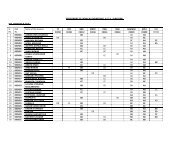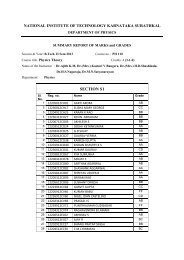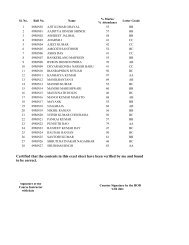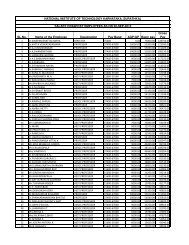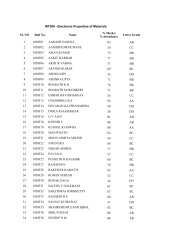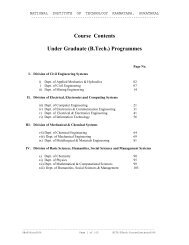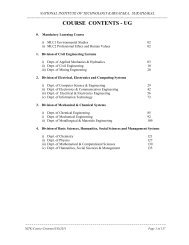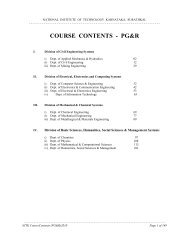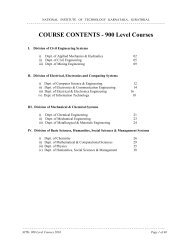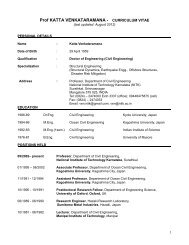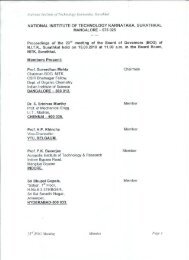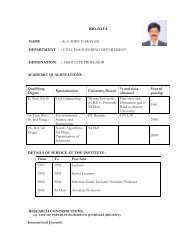course contents - ug - National Institute of Technology Karnataka
course contents - ug - National Institute of Technology Karnataka
course contents - ug - National Institute of Technology Karnataka
Create successful ePaper yourself
Turn your PDF publications into a flip-book with our unique Google optimized e-Paper software.
NATIONAL INSTITUTE OF TECHNOLOGY KARNATAKA, SURATHAKAL<br />
------------------------------------------------------------------------------------------------------------------<br />
EC420 ERROR CONTROL CODING (3-0-0) 3<br />
Coding for reliable digital transmission and storage. Groups, Rings, Vector Spaces, Galois Fields,<br />
Polynomial rings, Channel models, Linear Block codes, Cyclic codes, BCH codes, Reed Solomon Codes,<br />
Berlekamp-Massey and Euclid decoding algorithm, Decoding beyond the minimum distance parameter,<br />
Applications <strong>of</strong> Reed-Solomon codes, Convolutional codes, Decoding algorithms for Convolutional<br />
codes, Viterbi, Stack and Fano algorithms, Application <strong>of</strong> Convolutional codes. Codes based on the<br />
Fourier Transform, Algorithms based on the Fourier Transform, Trellis coded modulation, Combinatorial<br />
description <strong>of</strong> Block and Convolutional codes, Algorithms for the construction <strong>of</strong> minimal and tail biting<br />
trellises, S<strong>of</strong>t decision decoding algorithms, Iterative decoding algorithms, Turbo-decoding, Two-way<br />
algorithm, LDPC codes, Use <strong>of</strong> LDPC codes in digital video broadcasting, belief propagation (BP)<br />
algorithms, Space-Time codes.<br />
Shu Lin and Daniel J. Costello Jr., Error Control Coding: Fundamentals and Applications, Prentice Hall,<br />
2003.<br />
S. B Wicker, Error Control Systems for Digital Communication and Storage, Prentice Hall International,<br />
1995.<br />
Blahut R. E, Theory and Practise <strong>of</strong> Error Control Codes, Addison Wesley, 1983.<br />
Blahut R.E., Algebraic codes for Data transmission, Cambridge University Press, 2003.<br />
EC421 ELECTROMAGNETIC INTERFERENCE AND COMPATIBILITY (3-0-0) 3<br />
EMC requirements for electronic systems, EMI/EMC definitions, emission and immunity concepts,<br />
interference mechanisms, parameters and measurement units, EMI in time domain and frequency domain.<br />
Sources <strong>of</strong> electromagnetic interference; EMI coupling methods; EMI/EMC standards and<br />
measurements, EMI test instruments and systems, EMI control techniques; PCB design for EMC, high<br />
speed digital interconnects and signal integrity issues, system configuration and design for EMC.<br />
Henry W.Ott, Electromagnetic Compatibility Engineering, Wiley, 2010.<br />
C.R.Paul, Introduction to Electromagnetic Compatibility, Wiley, 2006<br />
Dipak L.Senguta, Valdis V.Liepa, Applied Electromagnetics and Electromagnetic Compatibility, Wiley,<br />
2006.<br />
V.P.Kodali, Engineering EMC Principles, Measurements and Technologies, IEEE Press, 2001.<br />
EC422 ADHOC AND SENSOR NETWORKS (3-0-0) 3<br />
Mobile ad hoc networks and wireless sensor networks concepts and architectures. Routing: proactive<br />
routing, Broadcasting and multicasting, TCP over mobile ad hoc networks,Wireless LAN (WiFi)<br />
standards, Medium Access Control Protocol issues power control, spatial reusability, and QoS,<br />
Bluetooth, Wireless sensor networks architecture: hardware and s<strong>of</strong>tware components <strong>of</strong> a sensor node,<br />
OS for WSN, WSN MAC layer strategies; naming and addressing; Clock Synchronization; Node<br />
Localization; WSN Routing<br />
C Sivarama Murthy and B S Manoj, Ad-Hoc Wireless Networks, Architectures and Protocols, PH , 2004.<br />
Labiod.H, Wireless Adhoc and sensor networks, Wiley, 2008.<br />
Li,X , Wireless ad hoc and sensor networks: theory and applications, Cambridge University Press,2008<br />
EC423 ADVANCED TOPICS IN COMMUNICATION ENGG (3-0-0) 3<br />
Fading Channels, characterizing Mobile radio propagation, Signal time spreading, time variance <strong>of</strong><br />
channel, mitigating the degradation effects <strong>of</strong> fading, characterizing fading channels, Fundamentals <strong>of</strong><br />
Statistical Detection Theory, Baye�s Theorem, Decision theory, Neyman Pearson Theorem, Receiver<br />
operating characteristics, Bayes�s risk. Multiple hypothesis testing, minimum Baye�s risk detection for<br />
binary hypothesis and multiple hypothesis, Orthogonal Frequency Division Multiplexing, OFDM<br />
transmission technique, synchronization, modulation, demodulation, amplitude limitation <strong>of</strong> OFDM<br />
signals. Space Time Wireless Communications, Introduction, space time propagation, space time channel<br />
and signal models, spatial diversity, space time OFDM<br />
B.Sklar, Digital Communications: Fundamentals and Application, Pearson Education, 2001.<br />
---------------------------------------------------------------------<br />
NITK-Course Contents(UG)2010 Page 51 <strong>of</strong> 134



